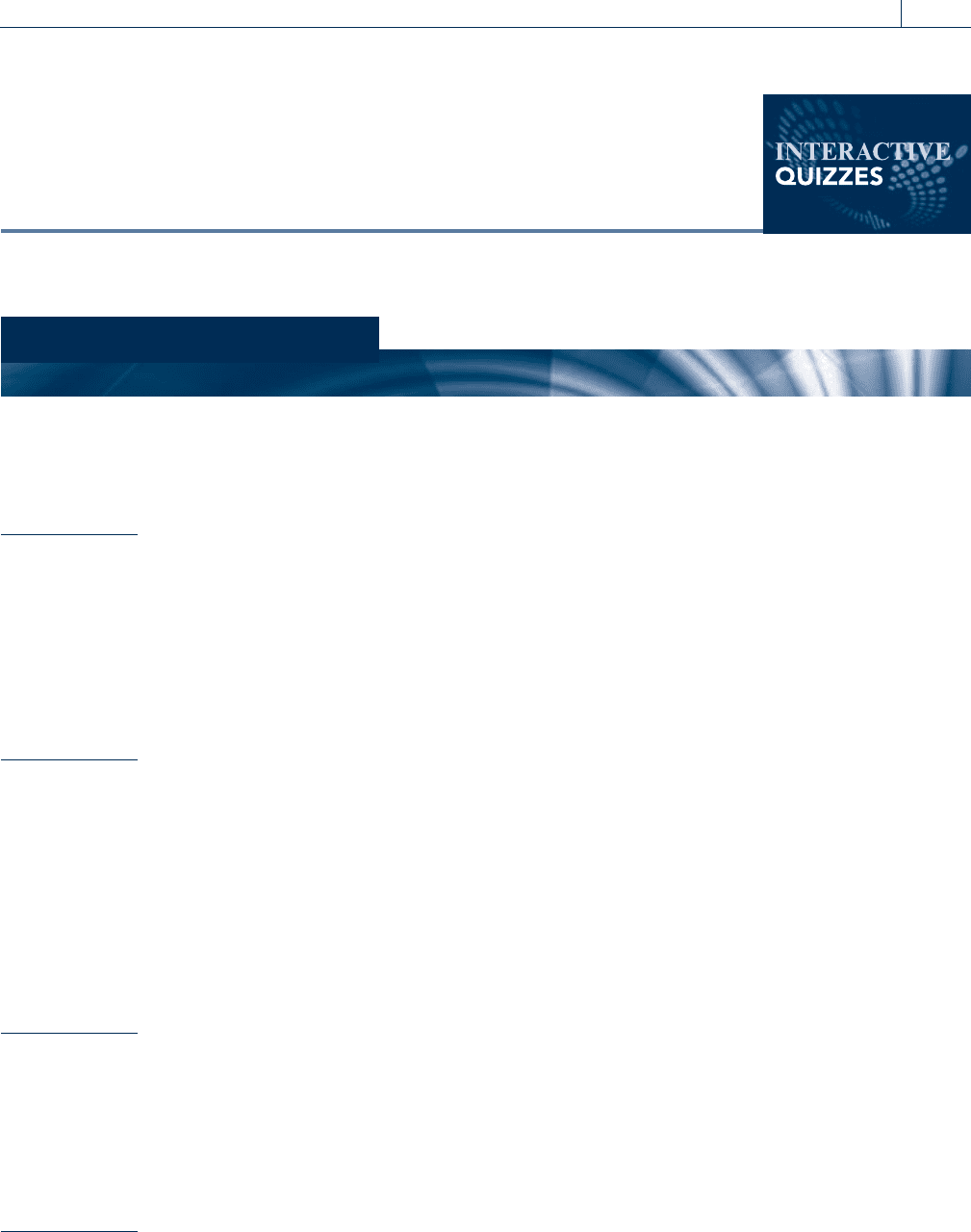Whittenburg Gerald E., Altus-Buller Martha. Income Tax Fundamentals
Подождите немного. Документ загружается.


KEY POINTS
Learning Objectives Key Points
LO 11.1:
Employ the corporate tax rates to
calculate corporate tax liability.
The United States corporate tax rate structure has eight tax brackets with marginal tax
rates ranging from 15 percent to 39 percent.
‘‘Bubbles’’ occur where the marginal corporate rate increases then decreases (e.g., from 34
percent to 39 percent and from 35 percent to 38 percent and back), and such bubbles
recapture the tax savings from the prior tax bracket’s progressive marginal rates.
For taxable income over $335,000 and less than or equal to $10,000,000, the corporate tax
rate is a flat 34 percent.
For large corporations with taxable income over $18,333,333, the corporate tax rate is a
flat 35 percent.
Qualified personal service corporations (health, law, engineering, architecture, accounting,
actuarial science, performing arts, and consulting) are taxed at a flat 35 percent tax rate on
all taxable income.
LO 11.2:
Compute basic capital gains and
losses for corporations.
Corporate ordinary income and capital gains rates are the same, so there is no benefit to
having long-term capital gains in a corporation.
Net short-term capital gains of a corporation are taxed as ordinary income.
Corporations are not allowed to deduct capital losses against ordinary income.
Capital losses may be used only to offset capital gains.
If capital losses cannot be used in the year they occur, they may be carried back 3 years
and forward 5 years to offset capital gains in those years.
When a long-term capital loss is carried to another year, it is treated as a short-term
capital loss.
LO 11.3:
Ascertain how special deductions
may affect corporate taxable
income.
Corporations are allowed a dividend received deduction based on their percentage of own-
ership in the corporation paying the dividend.
The deduction percentage is 70 percent (for ownership less than 20 percent), 80 percent
(for ownership of 20 percent or more, but less than 80 percent), or 100 percent (for owner-
ship of 80 percent or more).
Corporations amortize qualifying organization costs over 180 months, and there is no upper
limit to the amount of qualifying costs that can be amortized.
Corporations can elect to deduct up to $5,000 of organization costs in the year they begin
business (the $5,000 amount is reduced by each dollar of organization expenses exceeding
$50,000).
A corporation’s charitable contribution deduction is limited to 10 percent of taxable income,
computed before the deduction for charitable contributions, net operating loss carrybacks,
capital loss carrybacks, and the dividends received deduction.
Excess charitable contributions are carried forward to the 5 succeeding tax years, subject
to the 10 percent annual limitation in the carryover years.
LO 11.4:
Identify the components of Sched-
ule M-1 and how they are reported
to the IRS.
The purpose of Schedule M-1 of the corporate tax return is to reconcile a corporation’s
accounting income to its taxable income.
On the left side of Schedule M-1 are adjustments that must be added to accounting
income, and on the right side of the schedule are adjustments that must be subtracted
from accounting income.
The additions to book (accounting) income include the amount of federal income tax
expense, net capital losses deducted for book purposes, income recorded on the tax return
but not on the books, and expenses recorded on the books but not deducted on the tax
return.
Section 11.9
The Corporate Alternative Minimum Tax 11-27
Copyright 2010 Cengage Learning. All Rights Reserved. May not be copied, scanned, or duplicated, in whole or in part. Due to electronic rights, some third party content may be suppressed from the eBook and/or eChapter(s).
Editorial review has deemed that any suppressed content does not materially affect the overall learning experience. Cengage Learning reserves the right to remove additional content at any time if subsequent rights restrictions require it.

The amounts that must be deducted from book income include income recorded on the
books but not included on the tax return, and deductions included on the return but not
deducted on the books.
LO 11.5:
Know the corporate tax return
filing and estimated tax payment
requirements.
Corporate tax returns are due on or before the fifteenth day of the third month following
the close of the corporation’s tax year, but corporations may receive an automatic 6-month
extension by filing Form 7004.
A corporation must pay any tax liability by the original due date of the return.
Corporations must make estimated tax payments similar to those made by self-employed
individual taxpayers. The payments are due on the fifteenth day of the fourth, sixth, ninth,
and twelfth months of the corporation’s tax year.
LO 11.6:
Understand in general how
an S corporation is taxed and
operates.
Certain qualified small business corporations (S corporations) may elect to be taxed in a
manner similar to partnerships.
To elect S corporation status, a corporation must have the following characteristics: 1) be a
domestic corporation; 2) have 100 or fewer shareholders who are all either individuals,
estates, certain trusts, certain financial institutions, or certain exempt organizations; 3) have
only one class of stock; and 4) all shareholders must be U.S. citizens or resident aliens.
Each shareholder of an S corporation reports his or her share of corporate income based on
his or her stock ownership during the year.
Schedule K-1 of Form 1120S is used to report the allocation of ordinary income or loss and
all separately stated items of income or loss to each of the shareholders.
Losses from an S corporation pass through to the shareholders but are limited to the share-
holders’ adjusted basis in the corporation’s stock plus the amount of any loans from the
shareholder to the corporation.
LO 11.7:
Understand the basic tax rules for
the formation of a corporation.
If property is exchanged for stock in a corporation and the shareholders are in ‘‘control’’ of
the corporation after the transfer, gain on the transfer is not recognized.
The basis of the stock received by the shareholder is equal to the basis of the property
transferred plus any gain recognized by the shareholder, less the fair market value of any
boot received by the shareholder.
The basis of property received by the corporation is equal to the basis in the hands of the
transferor plus any gain recognized by the transferor.
Realized gain is recognized to the extent that the shareholder receives boot.
LO 11.8:
Describe the rules for the accumu-
lated earnings tax and the per-
sonal holding company tax.
The accumulated earnings tax is a penalty tax, imposed in addition to the regular corporate
income tax, at a rate of 15 percent on amounts that are deemed to be unreasonable accu-
mulations of earnings.
For all corporations, except service corporations such as accounting, law, and health-care
corporations, the first $250,000 in accumulated earnings is exempt from tax.
Personal holding companies, which are corporations with few shareholders and income pri-
marily from investments, are subject to an extra 15 percent tax on undistributed earnings.
LO 11.9:
Define the elements of the
corporate alternative minimum
tax (AMT) calculation.
The corporate alternative minimum tax is similar to the individual AMT.
The tax preferences that apply to the calculation of the alternative minimum tax for individ-
ual taxpayers generally apply to corporations.
Corporations, however, have certain adjustments which differ from those that apply to
individuals.
The AMT rate for corporations is 20 percent instead of the individual rate of 26 percent or
28 percent.
The corporate alternative minimum tax does not apply to small corporations as defined in
the tax law.
11-28 Chapter 11
The Corporate Income Tax
Copyright 2010 Cengage Learning. All Rights Reserved. May not be copied, scanned, or duplicated, in whole or in part. Due to electronic rights, some third party content may be suppressed from the eBook and/or eChapter(s).
Editorial review has deemed that any suppressed content does not materially affect the overall learning experience. Cengage Learning reserves the right to remove additional content at any time if subsequent rights restrictions require it.

Reinforce the tax information covered in this chapter by completing the online
interactive tutorials located at the Income Tax Fundamentals Web site:
www.cengagebrain.com.
QUESTIONS and PROBLEMS
GROUP 1:
MULTIPLE CHOICE QUESTIONS
.............................................. .............................................. .
LO 11.1
1. Ironwood Corporation has ordinary taxable income of $40,000 for calendar year 2010,
and a long-term capital loss of $20,000. What is the corporation’s tax liability f or
2010?
a. $4,500
b. $6,000
c. $7,500
d. $10,000
e. None of the above
LO 11.3
2. Walnut Corporation owns 60 percent of Teak Corporation, a domestic corporation.
During 2010, Walnut Corporation received $20,000 in dividends from Teak Corpo-
ration. Assuming that Walnut’s taxable income for 2010 before the dividends received
deduction is $500,000, what is the amount of Walnut’s dividends received deduction
for 2010?
a. $0
b. $14,000
c. $16,000
d. $20,000
e. None of the above
LO 11.3
3. Which of the following is not a corporate organizational expenditure that may be
amortized?
a. The cost of organizational meetings
b. Fees paid to the state for incorporation
c. Accounting fees incident to organization
d. Legal fees incident to organization
e. All of the above are organizational expenditures
LO 11.6
4. Which of the following is not required for a corporation to be classified as a small busi-
ness corporation and be eligible to make an S corporation election in 2010?
a. The corporation must have 100 or fewer shareholders.
b. The corporation must be a domestic corporation.
c. The corporation must have both common and preferred stock.
Questions and Problems 11-29
Copyright 2010 Cengage Learning. All Rights Reserved. May not be copied, scanned, or duplicated, in whole or in part. Due to electronic rights, some third party content may be suppressed from the eBook and/or eChapter(s).
Editorial review has deemed that any suppressed content does not materially affect the overall learning experience. Cengage Learning reserves the right to remove additional content at any time if subsequent rights restrictions require it.

d. The shareholders of the corporation must not be nonresident aliens.
e. All shareholders must be either individuals, estates, certain trusts, or financial
institutions.
LO 11.6
5. Which of the following items retains its character when passed through to sharehold-
ers of an S corporation?
a. Wages paid
b. Accelerated depreciation
c. Net long-term capital gains
d. Advertising expense
e. All of the above retain their character when passed through
LO 11.6
6. Which of the following is true about S corporations?
a. S corporations pay corporate taxes like other corporation s.
b. S corporations pay the alternative minimum tax for all income.
c. S corporations cannot issue corporate stock.
d. The S corporation status ma y be elected by stockholders only for corporations that
meet certain qualifications.
e. None of the above.
LO 11.7
7. Travis transfers land with a fair market value of $125,000, basis of $25,000, to a cor-
poration in exchange for 100 percent of the corporation’s stock. What amount of gain
must Travis recognize as a result of this transaction?
a. $0
b. $25,000
c. $100,000
d. $125,000
e. None of the above
LO 11.7
8. Carl transfers land with a fair market value of $120,000, basis of $30,000, to a new cor-
poration in exchange for 85 percent of the corporation’s stock. The land is subject to a
$40,000 liability, which the corporation assumes. What amount of gain must Carl rec-
ognize as a result of this transaction?
a. $0
b. $40,000
c. $30,000
d. $10,000
e. None of the above
LO 11.7
9. What is the shareholder’s basis in stock of a corporation received as a result of the
transfer of property to the corpo ration and as a result of which gain was rec ognized
by the stockholder?
a. The shareholder’s basis is equal to the basis of the property transferred less the gain.
b. The shareholder’s basis is equal to the fair market value of the stock received, less
any liabilities transferred by the stockholder.
c. The shareholder’s basis is equal to the basis of the property transferred to the cor-
poration, minus any liabilities transferred by the shareholder plus the gain.
d. The shareholder’s basis is equal to the basis of the property transferred to the cor-
poration, plus any liabilities transferred by the shareholder.
e. None of the above.
11-30 Chapter 11
The Corporate Income Tax
Copyright 2010 Cengage Learning. All Rights Reserved. May not be copied, scanned, or duplicated, in whole or in part. Due to electronic rights, some third party content may be suppressed from the eBook and/or eChapter(s).
Editorial review has deemed that any suppressed content does not materially affect the overall learning experience. Cengage Learning reserves the right to remove additional content at any time if subsequent rights restrictions require it.

GROUP 2:
PROBLEMS
.............................................. .............................................. .
LO 11.1 1. Quince Corporation has taxable income of $450,000 for its 2010 calendar tax year.
Calculate the corporation’s income tax liability for 2010 before tax credits.
$ ____________
LO 11.1 2. Ulmus Corporation has $1,230,000 in taxable income for 2010. Calculate the corpo-
ration’s income tax liability for 2010.
$ ____________
LO 11.2 3. For its 2010 tax year, Ilex Corporation has ordinary income of $240,000, a short-term
capital loss of $60,000, and a long-term capital gain of $20,000. Calculate Ilex Corpo-
ration’s tax liability for 2010.
$ ____________
LO 11.3 4. Fisafolia Corporation has gross income from operations of $220,000 and operating
expenses of $160,000 for 2010. The corporation also has $20,000 in dividends from
publicly traded domestic corporations (ownership in all corporations was less than
20 percent).
a. Calculate the corporation’s dividends received deduction for 2010.
$ ____________
b. Assume that instead of $220,000, Fisafolia Corporation has gross income from
operations of $135,000. Calculate the corporation’s dividends received deduction
for 2010.
$ ____________
LO 11.3 5. Beech Corporation, an accrual basis taxpayer, was organized and began business on
July 1, 2010. During 2010, the corporation incurred the following expenses:
State fees for incorporation $ 500
Legal and accounting fees incident to organization 1,800
Expenses for the sale of stock 2,100
Organizational meeting expenses 750
Assuming that Beech Corporation does not elect to expense but chooses to amortize
organizational expenditures over 15 years, calculate the corporation’s deduction for its
calendar tax year 2010.
$ ____________
LO 11.3 6. Citradoria Corporation is a regular corporation that contributes $35,000 cash to qualified
charitable organizations during 2010. The corporation has net operating income of
$140,000, before deducting the contributions, and dividends received from domestic cor-
porations (ownership in all corporations is less than 20 percent) in the amount of $20,000.
a. What is the amount of Citradoria Corporation’s allowable deduction for charitable
contributions for the current year?
$ ____________
b. What may the corporation do with any excess amount of contributions?
_________________________________________________ ______________________
_________________________________________________ ______________________
_________________________________________________ ______________________
_________________________________________________ ______________________
_________________________________________________ ______________________
Questions and Problems 11-31
Copyright 2010 Cengage Learning. All Rights Reserved. May not be copied, scanned, or duplicated, in whole or in part. Due to electronic rights, some third party content may be suppressed from the eBook and/or eChapter(s).
Editorial review has deemed that any suppressed content does not materially affect the overall learning experience. Cengage Learning reserves the right to remove additional content at any time if subsequent rights restrictions require it.

LO 11.6 7. Cedar Corporation has an S corporation election in effect. During the 2010 calendar
tax year, the corporation had ordinary taxable income of $200,000, and on January 15,
2010, the corporation paid dividends to shareholders in the amount of $120,000. How
much taxable income, in total, must the shareholders of the corporation report on their
2010 tax returns?
$ ____________
Explain your answer ________________________________________________________
__________________________________________________________________________
LO 11.6 8. Bill and Guilda each own 50 percent of the stock of Radiata Corporation, an S corpo-
ration. Guilda’s basis in her stock is $25,000. On July 31, 2010, Bill sells his stock, with
a basis of $40,000, to Loraine for $50,000. For the 2010 tax year, Radiata Corporation
has a loss of $100,375.
a. Calculate the amount of the corpora tion’s loss that may be deducted by Bill on his
2010 tax return.
$ ____________
b. Calculate the amount of the corporation’s loss that may be deducted by Guilda on
her 2010 tax return.
$ ____________
c. Calculate the amount of the corporation’s loss that may be deducted by Loraine on
her 2010 tax return.
$ ____________
LO 11.7 9. Karen, in forming a new corporation, transfers land to the corporation in exchange for
100 percent of the stock of the corporation. Karen’s basis in the lan d is $275,000, and
the corporation assumes a liability on the property in the amount of $300,000. The
stock receive d by Karen has a fair market value of $550,000.
a. What is the amount of gain or loss that must be recognized by Karen on this
transfer?
$ ____________
b. What is the amount of Karen’s basis in the corporatio n’s stock?
$ ____________
c. What is the amount of the corporation’s basis in the land?
$ ____________
LO 11.8 10. Grevilla Corporation is a manufacturing company. The corporation has accumulated
earnings of $950,000, and it can establish reasonable needs for $400,000 of that
amount. Calculate the am ount of the accumulated earnings tax (if any) that Grevilla
Corporation is subject to for this year.
$ ____________
LO 11.9 11. Cypress Corporation has regular taxable income of $170,000 (assume annual gross
receipts are greater than $5 million) and r egular tax liability of $49,550 for 2010.
The corporation also has tax preference items amounting to $105,000. Calculate
Cypress Corporation’s alternative minimum tax liability. Assume Cypress Corporation
is not a ‘‘small corporation.’’
$ ____________
11-32 Chapter 11
The Corporate Income Tax
Copyright 2010 Cengage Learning. All Rights Reserved. May not be copied, scanned, or duplicated, in whole or in part. Due to electronic rights, some third party content may be suppressed from the eBook and/or eChapter(s).
Editorial review has deemed that any suppressed content does not materially affect the overall learning experience. Cengage Learning reserves the right to remove additional content at any time if subsequent rights restrictions require it.

12. Go to the IRS Web site (www.irs.gov) and determine which IRS publication
addresses the topic of corporate taxation. Print out the page with the Table of Contents
of this IRS publication.
13. Go to the IRS Web site (www.irs.gov) and print out a copy of the most recent
Schedule D of Form 1120.
GROUP 3:
COMPREHENSIVE PROBLEMS
.............................................. .............................................. .
1. Olive Corporation was formed and began operations on January 1, 2010. The corpo-
ration’s income statement for the year and the balance sheet at year-end are presented
below.
The Olive Corporation Income Statement
for the Year Ended December 31, 2010
Gross income from operations $ 260,000
Qualified dividends received from a 10 percent
owned domestic corporation
20,000
Total gross income $ 280,000
Cost of goods sold
(105,000)
Total income $ 175,000
Other expenses:
Compensation of officers $75,000
Salaries and wages 30,000
Bad debts (direct charge-offs) 7,000
Repairs 3,000
Depreciation 10,000
Advertising 5,000
Payroll taxes
10,000
Total other expenses
(140,000)
Net income (before federal income tax expense)
$ 35,000
The Olive Corporation Balance Sheet
as of December 31, 2010
Assets:
Cash $ 30,000
Accounts receivable 20,000
Inventory (at cost) 80,000
Equipment 90,000
Less: accumulated depreciation
(10,000)
Total asset s
$210,000
Questions and Problems 11-33
Copyright 2010 Cengage Learning. All Rights Reserved. May not be copied, scanned, or duplicated, in whole or in part. Due to electronic rights, some third party content may be suppressed from the eBook and/or eChapter(s).
Editorial review has deemed that any suppressed content does not materially affect the overall learning experience. Cengage Learning reserves the right to remove additional content at any time if subsequent rights restrictions require it.

Liabilities and owners’ equity:
Accounts payable $ 13,150
Note payable (due in 10 years) 85,000
Common stock 80,000
Retained earnings
31,850
Total liabil ities and owners’ equity
$210,000
The corporation made estimated tax payments of $4,000 and the corporation’s fed-
eral income tax expense is equal to the federal tax liability. Complete Form 1120 for
Olive Corporation on pages 11-35 through 11-39. Do not complete Schedule G.
Schedule UTP is not required.
2. Assume that Olive Corporation, in Comprehensive Problem 1, is an S corporation
owned 50 percent by Linda Holiday and 50 percent by Ralph Winston. The corpora-
tion is not subject to any special taxes. Using the relevant in formation given in Com-
prehensive Problem 1 and assuming the corporation’s retained earnings are $35,000
instead of $31,850, accounts payable are $10,000 instead of $13,150, and no estimated
tax payments are made, complete Form 1120S for Olive Corporation and Schedule
K-1 for Linda on pages 11-41 through 11-46. Assume there were no cash distributions
during the year.
11-34 Chapter 11
The Corporate Income Tax
Copyright 2010 Cengage Learning. All Rights Reserved. May not be copied, scanned, or duplicated, in whole or in part. Due to electronic rights, some third party content may be suppressed from the eBook and/or eChapter(s).
Editorial review has deemed that any suppressed content does not materially affect the overall learning experience. Cengage Learning reserves the right to remove additional content at any time if subsequent rights restrictions require it.

Questions and Problems 11-35
Copyright 2010 Cengage Learning. All Rights Reserved. May not be copied, scanned, or duplicated, in whole or in part. Due to electronic rights, some third party content may be suppressed from the eBook and/or eChapter(s).
Editorial review has deemed that any suppressed content does not materially affect the overall learning experience. Cengage Learning reserves the right to remove additional content at any time if subsequent rights restrictions require it.

11-36 Chapter 11
The Corporate Income Tax
Copyright 2010 Cengage Learning. All Rights Reserved. May not be copied, scanned, or duplicated, in whole or in part. Due to electronic rights, some third party content may be suppressed from the eBook and/or eChapter(s).
Editorial review has deemed that any suppressed content does not materially affect the overall learning experience. Cengage Learning reserves the right to remove additional content at any time if subsequent rights restrictions require it.
